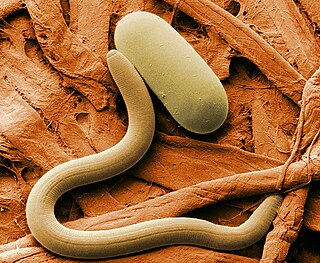
Secernentea was a class of nematodes in the Classical Phylogeny System and is no longer in use. This morphological-based classification system has been replaced by the Modern Phylogeny system, where taxonomy assignment is based on small subunit ribosomal DNA.

Heterodonta is a taxonomic subclass of saltwater clams, marine bivalve molluscs. This subclass includes the edible clams, the cockles and the Venus clams.

The Camallanida are an order of nematodes.

Tylenchida is an order of nematodes.

Subclass Spiruria comprises mostly parasitic secernentean nematodes. In an alternate classification, they are treated as suborder Spirurina, with the orders listed here being ranked as infraorders.

Spirurida is an order of spirurian nematodes. Like all nematodes, they have neither a circulatory nor a respiratory system.

Diplogasterida was an order of nematodes. It was sometimes placed in a monotypic subclass Diplogasteria, but molecular phylogenetic evidence has shown it to be embedded in the family Rhabditidae. The confusion of having a hierarchical nesting of groups that were formerly mutually exclusive has led to a profusion of names. Although completely revised taxonomy of nematodes that builds on recent classification systems as well as recent phylogenetic evidence is still necessary, most contemporary taxonomic studies now treat all groups listed under "Diplogasterina" below as a single family, Diplogastridae.

Slug, or land slug, is a common name for any apparently shell-less terrestrial gastropod mollusc. The word slug is also often used as part of the common name of any gastropod mollusc that has no shell, a very reduced shell, or only a small internal shell, particularly sea slugs and semislugs.

Thelazioidea is a superfamily of spirurian nematodes in the large order Spirurida. Like all nematodes, they have neither a circulatory nor a respiratory system.
Tetrameridae is a family of spirurian nematodes. It is the smallest of the large genera making up the bulk of the superfamily Habronematoidea. Like all nematodes, they have neither a circulatory nor a respiratory system. They are parasites, chiefly of birds and cetaceans.

The Onchocercidae are a family of nematodes in the superfamily Filarioidea. This family includes some of the most devastating human parasitic diseases, such as lymphatic filariasis, onchocerciasis, loiasis, and other filariases.

Thelazia callipaeda is a parasitic nematode, and the most common cause of thelaziasis in humans, dogs and cats. It was first discovered in the eyes of a dog in China in 1910. By 2000, over 250 human cases had been reported in the medical literature.
Spiruroidea is a superfamily of Spirurida.
Cystidicoloides tenuissima is a species of nematodes in the order Spirurida and family Cystidicolidae. It is a parasite of salmonid fish in the northern hemisphere and has mayflies as the alternate host.
Habronema is a genus of nematodes in the order Spirurida.

Physalopteridae is a family of spirurian nematodes, which belongs to the superfamily Physalopteroidea. Like all nematodes, they have neither a circulatory nor a respiratory system.

Ascarophis is a genus of parasitic nematodes, belonging to the family Cystidicolidae. Species of Ascarophis are parasitic as adults in the gastrointestinal tract of marine and estuarine fishes.

Ascarophisnema is a genus of parasitic nematodes, belonging to the family Cystidicolidae. Species of Ascarophisnema are parasitic as adults in the gastrointestinal tract of fish. According to the World Register of Marine Species, the genus currently (2019) includes a single species, Ascarophisnema tridentatum.

The subgenus Odatria, sometimes known as the dwarf monitor lizards, consists of small monitor lizards found in Australia and Indonesia. Species in this subgenus include the smallest monitor species in the world, the tiny 16 gram Dampier Peninsula monitor, but also includes some more medium sized species such as the 240 gram black-palmed rock monitor.

Ichthyofilaroides is a genus of parasitic nematodes, belonging to the family Guyanemidae Petter, 1974.
















